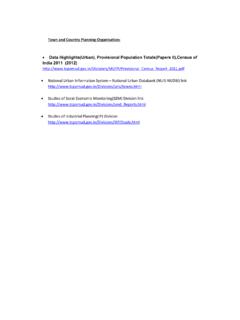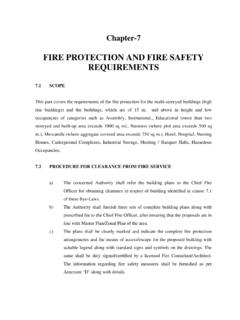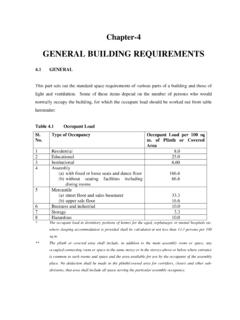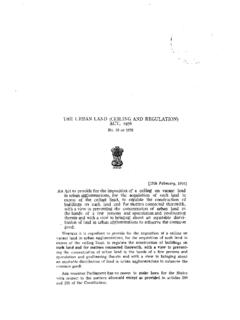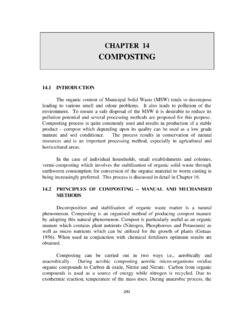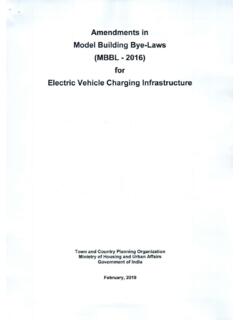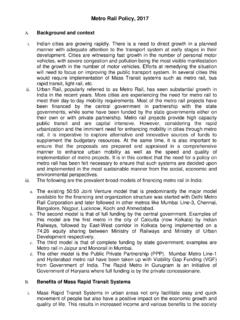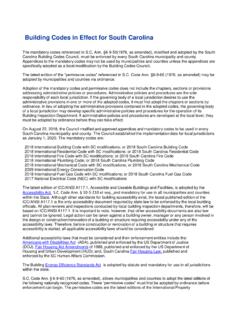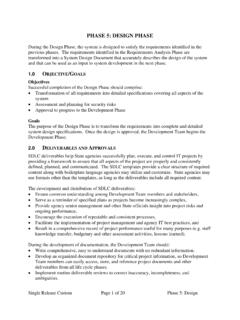Transcription of GENERAL BUILDING REQUIREMENTS
1 Chapter-4. GENERAL BUILDING REQUIREMENTS . GENERAL . This part sets out the standard space REQUIREMENTS of various parts of a BUILDING and those of light and ventilation. Some of these items depend on the number of persons who would normally occupy the BUILDING , for which the occupant load should be worked out from table hereunder: Table Occupant Load Sl. Type of Occupancy Occupant Load per 100 sq No. m. of Plinth or Covered Area 1 Residential 2 Educational 3 Institutional 4 Assembly (a) with fixed or loose seats and dance floor (b) without seating facilities including dining rooms 5 Mercantile (a) street floor and sales basement (b) upper sale floor 6 Business and industrial 7 Storage 8 Hazardous * The occupant load in dormitory portions of homes for the aged, orphanages or mental hospitals etc. where sleeping accommodation is provided shall be calculated at not less than persons per 100. ** The plinth or covered area shall include, in addition to the main assembly room or space, any occupied connecting room or space in the same storey or in the storeys above or below where entrance is common to such rooms and space and the area available for use by the occupants of the assembly place.
2 No deduction shall be made in the plinth/covered area for corridors, closets and other sub- divisions; that area shall include all space serving the particular assembly occupancy. Chapter-4 GENERAL BUILDING REQUIREMENTS SPACE REQUIREMENT FOR DIFFERENT PARTS OF BUILDING . Main BUILDING The plinth or any part of a BUILDING or outhouse shall be so located with respect to average road level from site so that adequate drainage of the site is assured but at a not height less than 45 cm. Interior Courtyards, Covered Parking Spaces and Garages These shall be raised at least 15 cm. above the surrounding ground level and shall satisfactorily drained. Habitable Rooms Size and Width The minimum size and width shall be as given in Table Table Minimum Size and Width of Different Components of Residential Premises Sl. Component of Min. requirement for plots Min. requirement for No. BUILDING upto 50 sq m. plots above 50 sq m.
3 1 Habitable Room Area sq m. Area sq m. Width m. Width m. Height m. Height m. 2 Kitchen Area sq m. Area sq m. Width m. Width m. Height m. Height m. 3 Pantry Area Not applicable Area sq m. Width Not applicable Width m. Height Not applicable Height m. 4 Bathroom Area sq m. Area sq m. Width m. Width m. Height m. Height m. 5 Area sq m. Area sq m. Width m. Height m. Height m. Height m. 6 Combined Bath & Area sq m. Area sq m. (Toilet) Width m. Width m. Height m. Height m. 7 Store Area No restriction Area No restriction Width No restriction Width No restriction Height m. Height m. 8 Projections Permitted within the setbacks Permitted within the upto m. width setbacks upto m. width 9 Canopy See clause See clause 59 Model BUILDING -Bye-laws Chapter-4 GENERAL BUILDING REQUIREMENTS Sl. Component of Min. requirement for plots Min. requirement for No. BUILDING upto 50 sq m. plots above 50 sq m. 10 Garage -- Area sq m.
4 Width m. Length m. Height m. 11 Passage -- Width m. 12 Doorways Habitable Width m. Width m rooms Height m. Height m. For kitchen bath, Width m. Width m. etc. Height m. Height m 14 Staircase Width m. Width m. No restriction for internal ladder Notes 1. Provided that the minimum clear head way under any beam shall be not less than m. 2. Maximum height permissible for all the components of the BUILDING mentioned above is 4 m. GROUP HOUSING. a) BUILDING requirement in respect of dwelling units upto 45 in size will correspond to Table and as applicable to plots upto 50 sq m. b) BUILDING requirement in respect of dwelling units above 45 sq m. may be referred from the Table applicable to above 50 sq m. plot size. c) Projection into Open Spaces without counting towards FAR. i) All open spaces provided either in interior or exterior shall be kept free from any erections thereon and shall open to the sky.
5 Nothing except cornice, chhajja or weather shade (not more than m. wide) shall overhang or project over the said open space so as to reduce the width to less than minimum required. Note: Such projections shall not be allowed at height less than m. from the corresponding finished floor level: ii) One canopy per block on the ground floor not exceeding m. in length and m. in width iii) Balcony at roof slab level of m. width and area not exceeding sq m. per bedroom but not exceeding 3 in number per flat. 60 Model BUILDING -Bye-laws Chapter-4 GENERAL BUILDING REQUIREMENTS iv) Balcony having entrance from the toilet/bathroom and width as m. for drying clothes. NON-RESIDENTIAL BUILDINGS. The minimum area for office room/shop or any other space to be used as workspace shall not be less than sq m. with a minimum width of m. OTHER GENERAL REQUIREMENTS : Kitchen Every room to be used as a kitchen shall have a) Unless separately provided in a pantry, means for washing of kitchen utensils, which shall lead directly or through a sink to a grated and trapped connection to the waste pipe.
6 B) An impermeable floor;. c) At least a window not less than 1 sq m. in area open directly to an interior or exterior open space, but not into a shaft and;. d) In residential BUILDING 15 m. or more in height, refuse chutes. Bathroom and W. C. Every bathroom or water closet shall a) Be so situated that atleast one of its walls shall open to external air and shall have a minimum opening in the form of window or ventilation to the extent of sq m. b) Not be directly over any room other than another latrine, washing place, bath or terrace unless it has a watertight floor. c) Have the platform or seat made of watertight non-absorbent material. d) Be enclosed by walls or partitions and the surface of every such wall partition shall be finished with a smooth impervious material to a height of not less than m. above the floor of such a room. e) Be provided with an impervious floor covering, sloping towards the drain with a suitable grade and not towards verandah or any other room.
7 61 Model BUILDING -Bye-laws Chapter-4 GENERAL BUILDING REQUIREMENTS f) No room containing water closets shall be used for any purpose except as a lavatory. g) Every water closet and/or a set of urinals shall have flushing cistern of adequate capacity attached to it h) A toilet on terrace having a maximum of mt. height shall be permitted subject to condition that the area of toilet be counted in FAR. i) All the sewage outlets shall be connected to the Municipal Sewerage system. Where no such system exists, a septic tank shall be provided within the plot conforming to the REQUIREMENTS . Loft Lofts shall be permitted in residential BUILDING and shops only. Area of such loft shall be restricted to 25% of the covered area or respective floor. Minimum height between loft and ceiling shall be m. and the clear height below the loft shall be as stipulated in the BUILDING Bye-Laws for the space below it. Mezzanine Floor Mezzanine floor may be permitted with the minimum height of m.
8 Between any two floors above ground in all types of BUILDING provided the same is counted as part of total permissible floor area ratio and height of the BUILDING . Basement The construction of the basement shall be allowed by Authority in accordance with the land use and other provisions specified under the Master Plan/Zonal Plan. The basement shall have the following requirement: i) Every basement shall be in every part at least m. in height from the floor to underside of the roof slab or ceiling and with maximum height not more than m. ii) Adequate ventilation shall be provided for the basement. The standard of ventilation shall be the same as required by the particular occupancy according to BUILDING Bye-Laws. Any deficiency may be met by providing adequate mechanical ventilation in the form blowers, exhaust fans (one exhaust fan for 50 sq m. basement area), air-conditioning system, etc. 62 Model BUILDING -Bye-laws Chapter-4 GENERAL BUILDING REQUIREMENTS iii) The minimum height of the ceiling of any basement shall be m.
9 And maximum of mt. above the average road level on the front side of the BUILDING . iv) Adequate arrangement shall be made such that surface drainage does not enter the basement. v) The walls and floors of the basement shall be watertight and be so designed that the effect of the surrounding soil and moisture, if any, are taken into account in design and adequate damp proofing treatment is given. vi) The access to the basement shall be either from the main or alternate staircase providing access to the BUILDING . No direct entry from the road shall be permitted to the basement. vii) Basement in an individual plot touching the adjacent property shall be allowed subject to following: a) In all cases the owners shall have to indemnify the local body against any damage caused by her/him/them to the adjacent property (Appendix-B-1). b) In case the portion of the basement projecting out of the BUILDING line that shall flush with the ground.
10 Viii) In case partition in the basements are allowed by the Authority, no compartment shall be less than sq m. in area and each compartment shall have ventilation standards as laid down in sub-clause (ii), above separately and independently. The basement partition shall however, confirm to the norms laid down by Fire Services. Garage i) The plinth of garage located at ground level shall not be less than 15 cm. above the surrounding ground level. ii) The garages shall be setback behind the BUILDING line of the street/road on to which the plot abuts and shall not be located affecting the access ways to the BUILDING . If the garage is not setback as aforesaid, the Authority may require the owner or occupier of the garage to discontinue its use as such or to carry out such structural alterations to the premises or to take such other measures 63 Model BUILDING -Bye-laws Chapter-4 GENERAL BUILDING REQUIREMENTS as the Authority may consider necessary in order to prevent danger or obstruction to traffic along the street.
